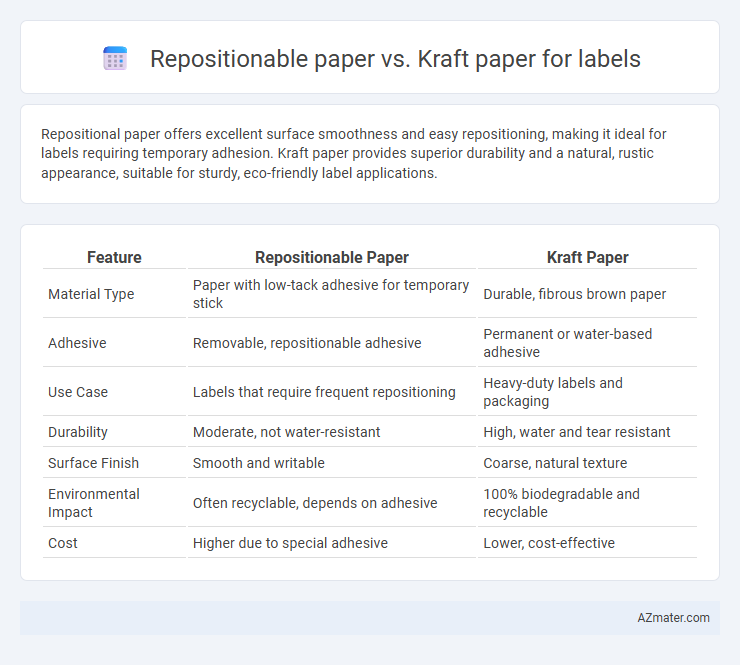Repositional paper offers excellent surface smoothness and easy repositioning, making it ideal for labels requiring temporary adhesion. Kraft paper provides superior durability and a natural, rustic appearance, suitable for sturdy, eco-friendly label applications.
Table of Comparison
| Feature | Repositionable Paper | Kraft Paper |
|---|---|---|
| Material Type | Paper with low-tack adhesive for temporary stick | Durable, fibrous brown paper |
| Adhesive | Removable, repositionable adhesive | Permanent or water-based adhesive |
| Use Case | Labels that require frequent repositioning | Heavy-duty labels and packaging |
| Durability | Moderate, not water-resistant | High, water and tear resistant |
| Surface Finish | Smooth and writable | Coarse, natural texture |
| Environmental Impact | Often recyclable, depends on adhesive | 100% biodegradable and recyclable |
| Cost | Higher due to special adhesive | Lower, cost-effective |
Understanding Repositional Paper: Key Features
Repositional paper for labels features a pressure-sensitive adhesive that allows easy removal and repositioning without leaving residue, making it ideal for temporary labeling and applications requiring frequent updates. It offers a smooth surface for high-quality printing and compatibility with various printers, ensuring clear, vibrant images and text. In contrast, kraft paper labels provide a robust, rustic appearance with durable fiber content but lack the repositionable adhesive properties, making them more suitable for permanent, eco-friendly labeling solutions.
What Is Kraft Paper? An Overview
Kraft paper is a strong, durable paper made from wood pulp through the kraft process, characterized by its high tear resistance and natural brown color, making it ideal for packaging and labeling. Unlike repositionable paper, which is designed to be temporarily adhesive and removable, kraft paper offers permanent sturdiness and environmental friendliness for labels that require longevity and strength. Its biodegradable and recyclable properties enhance its appeal for sustainable labeling solutions in various industries.
Comparing Adhesion: Repositional vs. Kraft Paper
Repositional paper offers moderate adhesion that allows labels to be easily removed and repositioned without leaving residue, ideal for temporary labeling needs. Kraft paper features strong, durable adhesion suited for permanent labels on rough or textured surfaces, providing long-lasting hold and resistance to tearing. The choice between repositional and kraft paper depends on whether label removability or permanent adhesion is prioritized.
Print Quality and Compatibility
Repositional paper offers superior print quality with sharp, clear images ideal for detailed label designs, while Kraft paper provides a more rustic, natural aesthetic with slightly lower resolution print output. Repositional paper is compatible with various printers, including laser and inkjet, making it versatile for different labeling needs, whereas Kraft paper performs best with thermal transfer and flexographic printing methods due to its coarse texture. Choosing between the two depends on the desired label appearance and printing technology, with repositional paper excelling in precision and Kraft paper offering durability and eco-friendly appeal.
Durability and Resistance Factors
Repositional paper for labels offers moderate durability with easy removability and repositioning, making it suitable for temporary applications but less resistant to moisture and abrasion. Kraft paper labels provide superior durability and resistance against tearing, chemicals, and environmental factors due to their natural fiber composition, ideal for long-term and heavy-duty labeling. Choosing between repositional and kraft paper depends on the required balance between removability and durability in label performance.
Application Versatility for Labels
Repositional paper offers exceptional versatility for label applications due to its easy peel-and-stick feature, making it ideal for temporary labeling, product trials, and inventory tags. Kraft paper, known for its durability and natural texture, suits labels requiring strong adhesion and a rustic aesthetic, often used in artisanal products and packaging. The choice between repositional and kraft paper depends on the label's intended use, with repositional excelling in flexibility and reusability, while kraft provides robustness and environmental appeal.
Environmental Impact: Sustainability of Both Papers
Repositionable paper often contains synthetic adhesives that can hinder recycling processes, resulting in higher environmental impact compared to kraft paper, which is made from natural fibers and is biodegradable and easily recyclable. Kraft paper production utilizes minimal chemicals and energy, contributing to its sustainability and lower carbon footprint. Brands prioritizing eco-friendly labeling typically choose kraft paper for its renewable sourcing and compostable properties, reducing long-term environmental harm.
Cost Comparison: Budget Considerations
Repositional paper offers higher upfront costs compared to kraft paper but can reduce expenses through its ease of application and repositioning, minimizing waste during label placement. Kraft paper is typically more budget-friendly initially, making it suitable for large-volume runs with straightforward labeling needs. Choosing between the two depends on balancing immediate material costs against potential savings from reduced errors and waste in the labeling process.
Use Cases: Best Industries for Each Paper Type
Repositional paper excels in retail and logistics industries where temporary labeling and easy removal without residue are critical, such as inventory management and price tagging. Kraft paper, known for its durability and rustic appearance, suits packaging, food labeling, and artisanal products, thriving in industries like food and beverage, crafts, and eco-friendly packaging. Each paper type targets specific use cases: repositional paper optimizes efficiency in fast-changing environments, while kraft paper enhances brand presentation and product protection.
Choosing the Right Paper for Your Labels
When selecting the right paper for your labels, consider the intended application and surface type; repositionable paper offers temporary adhesion ideal for product trials or seasonal promotions, whereas kraft paper provides a durable, rustic look suited for branding and packaging. Kraft paper labels are favored for their natural brown color and strength, enhancing eco-friendly and artisanal product appeal, while repositionable paper is designed to peel off cleanly without residue, making it perfect for reusable or movable labels. Evaluating factors such as adhesion needs, durability, and aesthetic alignment ensures optimal label performance and brand presentation.

Infographic: Repositional paper vs Kraft paper for Label
 azmater.com
azmater.com